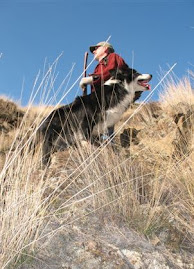
Six years into retirement, old Bonnie dog sleeps most of the day. Often deep in dreams, legs twitching,she sleeps so hard you can raise her foot off the ground and drop it, and she doesn’t notice a thing.
To wake her, you have to poke her or stomp on the floor in front of her face. When she does wake up, it’s as if a shot has gone off and she lunges up off the ground a couple inches.
In my mind I see her when she was younger, when she never stopped moving and seemed to flow over the ground. All of her fit together and worked together. She had speed, agility, stamina.
For most of her life, she never missed a day’s work. Always a header, she would swing in a continuous arc alongside the herd, up and back, up and back. Sometimes she'd circle clear around and I wouldn't notice her slipping in front until the whole herd stopped. Squinting to see what was going on, I'd catch a glimpse of her slender form, quiet and focused, gliding back and forth, holding the lead.

During her last winter at age 18, she would get up every morning, unfold her stiff bones from her canvas bed under the bench and totter to the the back porch screen door. The night is likely to have been close to zero and inside the porch it’s not much warmer. If the door is propped open, she wobbles briefly at the top of the four cement stairs and executes a controlled fall to the wooden deck below.
Her momentum carries her into the frozen yard where she aims towards the pasture. It’s been a long night and she really needs to pee. She reaches the yard fence and relieves herself and slowly begins her laps around the house. First she navigates east along the north-side past the garden, then turns south past the lilacs along the ditch, then turns west under the overgrown honeysuckle, past the pumphouse and then north again.
As her stiff hind legs warm up, she breaks into a loose jog, remembering the stride that followed the cattle across the prairies and canyons. She rounds the house again and again and I see her pass by the kitchen window every few minutes for the next half hour.
Soon she will wobble up the back porch steps again and fold herself onto her worn bed under the bench. As she drifts into slumber, her body relaxes, her legs extend, her chest rises and falls--her lips opening with a little puff of breath. Her toes begin to twitch. Where is she now I wonder. Is she deep in the canyon climbing a rocky trail and dodging prickly pear? Or is she high on a ridge, threading the tall pines, following the scent of the herd?
From Sara at Magpie Ranch, home of Bunchgrass Beef






































